Don’t you agree?
I’ve seen some pretty complicated kimchi recipes out there. First you have to brine the cabbage. Then you brine, separately, the daikon. Then you pour off the brine, reserving it, and then…
Maybe in their own painstaking way, those methods are more auténtico than mine. I don’t bury mine in the backyard, either, by the way. Nevertheless, it’s good. Spicy, sour, and slightly sweet, in our home it accompanies fried eggs and baby bok choy sautéed with onions, plum sauce glazed roast duck, or ginger-carrot soup with shrimp.
I eat a bit of kimchi almost everyday (on days when I don’t, I eat sauerkraut instead) and for the past few days, I’d been eying our last quart nervously, knowing I needed to get another jar put up soon so it would be ready in time. I like mine to ferment at room temperature for a few days and then finish up in the fridge for another couple weeks. So, it was time to get on it!
Traditionally in Korea, kimchi varied with the seasons. In the spring, summer, and fall, lightly fermented vegetables such as radish and cucumbers were prepared and consumed quickly. In November, households gathered together to prepare large batches of winter kimchi or kimjang, slicing and salting vegetables, packing them into earthenware jars, and burying the jars neck-deep in the ground. There, the vegetables would ferment and be kept safe from freezing, while providing nourishment until fresh greens were available again in spring.
Like so many traditional foods, everyone who makes it has his or her own special recipe for kimchi. This is the kimchi I make from fall through spring. It’s rather pretty packed in glass jars and full of locally grown ingredients (the cabbage and bok choy get scarce around here in the depths of winter, but everything else is local). When mandarin oranges are in season, I like to add those. I encourage you to play around and add what you like to your kimchi.
I don’t particularly recommend the fish sauce I have pictured below. I happened to run out just before a recent lactofermentation class and didn’t have time before class to get to our local Asian market, so I picked up this bottle at a grocery store. It just doesn’t have much fish flavor and I’m glad I’m nearly out of it. If you have a Korean or Asian specialty market nearby, see if you can find jeotgal, Korean fish sauce. Otherwise, the Vietnamese brand Three Crabs is a good one. You may notice that my recipe doesn’t include green onions, while many kimchi recipes do call for them. I just don’t like the taste of fermented onions, personally. If you do, by all means, include them.
When I was first figuring out kimchi for myself, I came across this Ultimate Kimchi recipe. What liked especially is Eric’s advice about mindset.
As you wash the vegetables, focus on your inner cooking. As you prepare the food, prepare your mind. Recognize that the way you prepare this meal is the way you are preparing your life. Put your total energy and attention into it. Clean your mind of all surface troubles and tribulations, all worries and fears. Focus on this exact moment in time. Observe the colors and textures of the vegetables. Feel them in your hand. Relax. Connect with your purpose and with the purpose of those who will be eating this food. Recognize that you are preparing totally healthy, life-giving fuel. Feel the love that you are demonstrating for yourself and for others as you perform this important service. Smile inside. This is going to be great! Its going to taste awesome!
Focus. Relax. Smile inside. Feel the love. Let’s make some kimchi!
Kimchi
Makes about 2 quarts
1 Napa cabbage
1 bok choy
1 daikon radish
1 very large carrot or a couple not so large carrots
1 green apple, peeled and chopped
1/4 cup sea salt
1/4 cup fish sauce or jeotgal (Korean fish sauce) if you can find it
0-4 tablespoons Korean chili flakes (I used add a pinch, but now do about 2 tablespoons)
2 tablespoons grated ginger
2 tablespoons grated garlic
1 teaspoon honey
a tablespoon or so of sesame seeds
Prepare the vegetables: Cut the cabbage into lengthwise quarters.
Slice the cabbage into 1-inch widths.
Slice the bok choy into 1-inch widths.
Thinly slice carrot and daikon.
Put all the vegetables and apple in a large bowl.
Prepare the paste: Grate the ginger and garlic.
Put ginger, garlic, salt, fish sauce, chili, and honey in a bowl and mix until it forms a paste.
Add the paste to the vegetables and gently massage it in, mixing the vegetables thoroughly.
Notice that the vegetables begin to glisten as the salt draws water from them.
At this point, I walk away for an hour or so, leaving the salt to draw water from the vegetables and create a brine.
Pack the kimchi into glass jars or a ceramic crock. Press down hard on the vegetables, they need to be tightly packed to ferment properly.
Leave at least 2-inch of head space and cover the vegetables with brine. Cover with a lid. I prefer to use plastic one-piece lids or reusable plastic-and-rubber-ring lids with metal rings. Regular metal canning lids contain BPA and they also tend to rust when in contact with acidic ferments.
Place the jars on a tray to capture any liquid that may overflow during the initial fermentation. Leave out on the counter for 3-4 days, then refrigerate. I like kimchi best after about two weeks of refrigeration. Keeps forever and gets milder with age.
Shared at: Monday Mania, Grain-Free Tuesdays





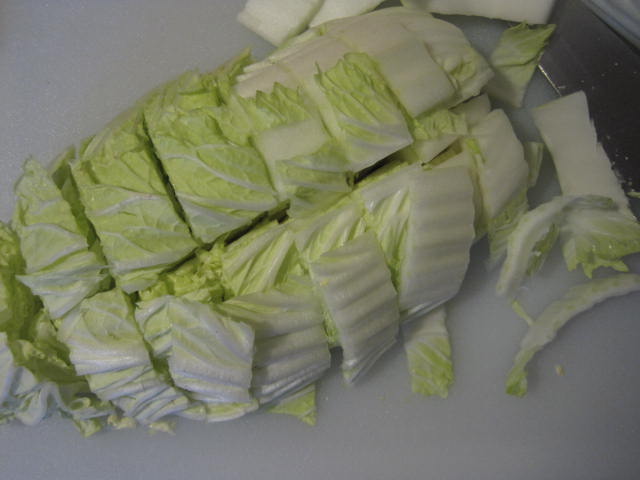


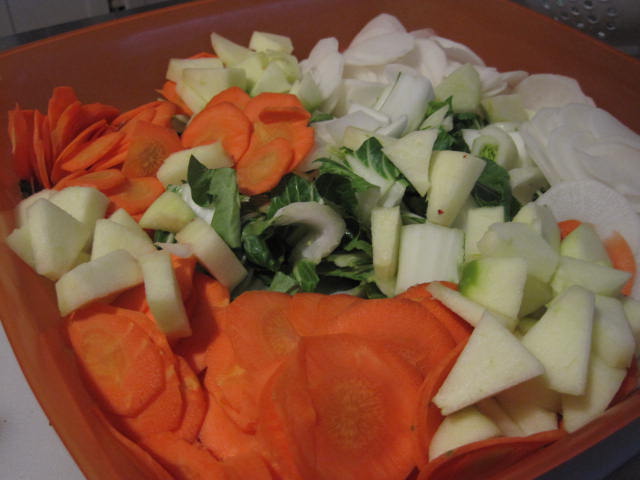


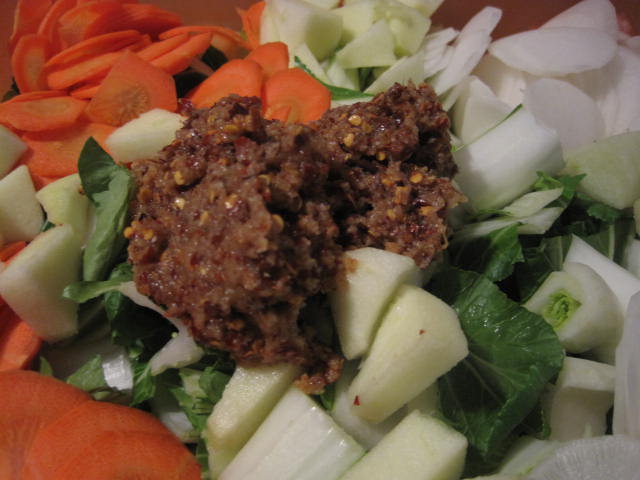

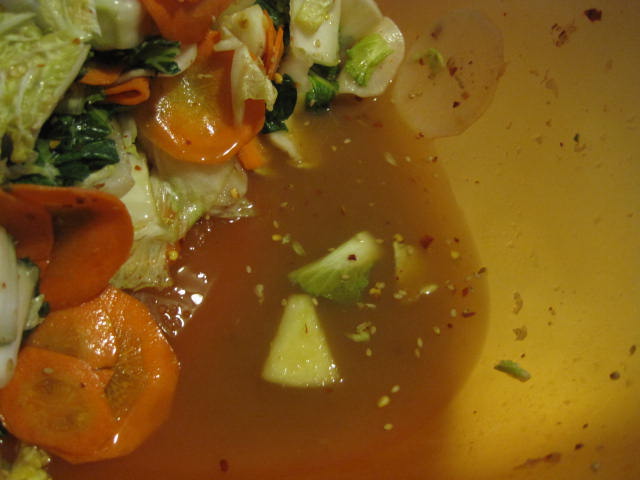
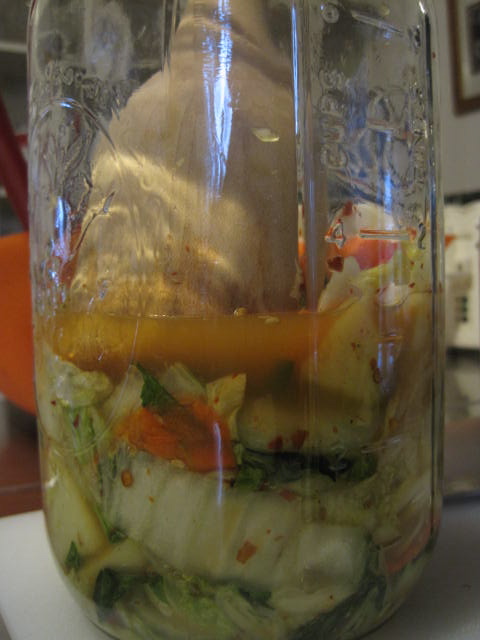
Pingback: Kimchi: The Prettiest Ferment « Cooking GAPS
Pingback: Gingered Carrot Soup with Shrimp « Cooking GAPS
Hi Lost Kitchen Arts,
Just received your kim chi recipe. I wanted to share my recipe with you. My family loves this recipe:
http://eatkamloops.org/archives/3627
It is really wonderful to see other people interested in traditional foods. I am very glad there is renewed interest in traditional food preparation that actually increases the nutrition in the food.
In Health,
Caroline Cooper
WAPF Kamloops Chapter
Oh, this looks delicious! I need to add kimchi to my repertoire of ferments (I usually just make salsa, sauerkraut, beet kvass, and vegetable medley). Thanks for the inspiration!
Glad to help! I’ve been obsessing about your red cracker recipe, by the way!
Oh, great, I’m glad you like the crackers! I currently have a batch of yellow ones in the fridge (made with yellow bell pepper instead since there weren’t any red ones at the store).
Looks like you put lots of chili in your kimchi, nice and traditional. I got pathetic with spice when we started our GAPS diet, but am feeling a bit bolder now. I especially love how you start out the recipe with the beautiful method from Eric on settling yourself and preparing the food with love and respect. I will definitely try this the next time I make kimchi. It is indeed the prettiest.
I’ve had to work up to that, Renee! What’s always amazing to me is how the same kimchi, which I can tolerate cold, turns any soup practically unbearably spicy, even when I add just a tiny bit. I’m going to make very mild kimchi just for having with soup.
I made a version of this over the weekend, although they didn’t have any daikon radish or napa cabbage at the co-op so I upped the carrots and bok choy. This is the first time I’ve used apples in a ferment and I’ve noticed they are turning slightly pink, kinda like they are oxidizing or something. Is that normal?
Sarah, I haven’t seen this with fermenting apples, but I have had it happen when cooking them at least once. I’m guessing your apples were higher than usual in the same phenols that turn quinces pink. They’re present in apples and pears, but usually in much smaller amounts.
Okay, thanks Chris. I’ll let you know how it turns out.
Pingback: Sweet Success with Sauerkraut | Lost Arts Kitchen
I came across your recipe and thought I’d try it, never made Kimchi before, only regular sauerkraut. DD26 is on GAPS (so I’m always on the hunt for more inspiration) and our garden is producing well. I thought I’d preserve some of the lovely Pak Choi before the weather gets too warm!
I didn’t have Napa cabbage, so I added some sauerkraut from a previous batch and used Pak Choi, regular radishes, carrots and apple. I only used 2 T of the fish sauce and 1/2 teaspoon of crushed red pepper flakes. I figured that surely using a “starter” of sauerkraut couldn’t hurt! I weighed all ingredients in grams so I could easily tweak it next time if needed. 🙂
I love the photos!
Thanks! Neat blog, I’ll be back.
I would like to know how Debbie Ms turned out with the sauerkraut. Thanks
hi, may i know whether can i freeze my homemade kimchi?
I have never tried freezing a ferment, but I would imagine that freezing would destroy the texture.
Tell me about the ‘brine’ to use please!
I have never made this but sure looks like something I would like!
Thanks!
I made your recipe, but reduced both the salt and fish sauce, and left out the honey entirely. All the other ingredients I used exactly as specified. After 3 full days of fermenting in my 70-72 degree kitchen the kim chi has great flavor but is much too salty. I am surprised because I reduced the salt! Is there some way to save this? I can’t imagine sitting down to eat a serving of it by itself, which is really how I like to enjoy it. I plan on letting it sit for another few days in hopes that the saltiness will somehow lessen, but I would love some advice. It is fermenting well, as I have to release the pressure from the jars at least twice a day and when I do it fizzles and spills out.
I know I could rinse it but don’t want to get rid of those great little critter living in the brine…
Are you usually able to eat ferments you make after just a few days? I find ferments too salty when they are that young. Usually, I let kimchi ferment at room temp for four days, then refrigerate for at least a week or two before consuming. Fermentation continues and reduces the salty flavor.
I can’t find Korean chili powder right now, can I use red pepper flakes?
Yes! I’ve used all sorts of pepper–including chipotle!
Hi again, Chris! I love your step by step instructions here, it made my first attempt at kimchi easy last night. Is it ok that I can smell it this morning? I loosely lidded my jars. And, is it normal for there to be air bubbles throughout, or should I do something about that? Thanks! 🙂
Chris, your pictures make my mouth water and Eric’s advice about mindset made my day! It’s precisely this kind of dedication that can turn cooking into a meditation. I discovered kimchi on the show called “bizarre foods” some years ago and wanted to try it ever since. This winter I had the chance to have a taste when someone took me to a Korean restaurant in Guangzhou. The balance between structure, saltiness, chili, cabbage taste and fermentedness is just perfect.
Stumbling across your recipe meant there was no escaping it; I had to make this divine dish myself. As usual, things got quite out of hand when I started. As we speak a massive amount of your recipe is waiting to be but in huge jars. Circumstances (and some pleasant inhibitions) made me alter some ingredients. I can’t wait to taste the result. Thanx big time for inspiring me.
Can you just leave the fish sauce out all together or replace it with something else?? I’m allergic.
You could leave it out, but you would need more salt. You could also try replacing with coconut aminos or soy sauce.
Hi there, thanks for your recipe. Do you store your kimchi in the fridge until you eat it, or could I store it in my basement (it’s a pretty cool, dark place)? I don’t know if I could spare the room in the fridge.
I store mine in the fridge. I haven’t experimented with basement storage, but if yours is 55F or cooler, that should be sufficient.
Pingback: Grain-Free Tuesdays 7 :: Hella Delicious
Good article
Thanks for the recipe